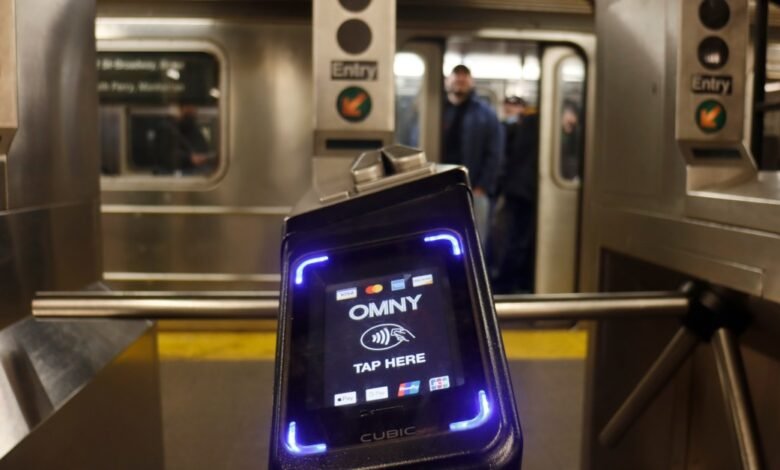Tap-to-Pay: The Future of Public Transit?

▼ Summary
– The MetroCard is being phased out in New York City, replaced by tap-to-pay systems like OMNY, Apple Pay, and Google Pay for subway payments.
– Many U.S. cities are adopting contactless fare systems, but adoption faces challenges including security concerns and accessibility issues for unbanked or low-income riders.
– The COVID-19 pandemic accelerated the shift to contactless payments to promote touch-free experiences and modernize transit systems.
– Despite some rider complaints about technical issues, OMNY has achieved high usage in New York, with 75% of riders using it as of July 2025.
– Contactless payments are part of broader efforts to improve transit, but agencies still face financial deficits and service cuts, requiring multiple solutions beyond fare upgrades.
The shift toward tap-to-pay systems is rapidly reshaping how millions of people access public transportation, offering a faster, more convenient alternative to traditional fare payment methods. This move away from magnetic-stripe cards and tokens represents one of the most significant technological upgrades in urban transit in recent memory.
I can still recall my first experience using a smartphone to enter the New York City subway. Holding my device to the reader, watching the green light flash, and hearing the turnstile unlock felt like stepping into a new era. After two decades of service, the MetroCard has now followed the brass token into history, with the MTA halting sales of the iconic cards by year’s end. Near-field communication technology through credit cards and mobile payment apps has become the new standard for subway access.
While New Yorkers have grown accustomed to the OMNY tap-to-ride system over recent years, other metropolitan areas are still catching up. Bay Area Rapid Transit recently joined the growing list of systems implementing contactless payment, alongside Philadelphia, Chicago, San Juan, and Washington, DC. Cities like London have operated tap-to-pay transit for years, while others continue struggling with outdated swipe systems.
The transition hasn’t been entirely smooth. Many passengers remain hesitant about these new payment methods. Significant equity concerns exist for low-income individuals who may lack bank accounts, reliable internet access, or smartphones necessary for these systems. Security vulnerabilities also pose risks, potentially exposing users to fraud or identity theft. Meanwhile, transit agencies nationwide confront substantial budget gaps as passenger numbers remain below pre-pandemic levels.
London pioneered contactless transit payments, introducing the technology for buses in 2012 and expanding to the Underground by 2014. New York considered similar systems for years before Governor Andrew Cuomo’s mid-2010s push to modernize the subway. The COVID-19 pandemic accelerated adoption across many cities, as transit officials recognized the dual benefits of touch-free payment and familiar transaction methods.
Progress in the United States faced multiple obstacles. Transit agencies often found themselves locked into long-term equipment contracts, while financial institutions delayed issuing contactless cards. Early adopters like Chicago and Salt Lake City encountered challenges achieving widespread usage. Security issues in New York’s OMNY system, which initially allowed potential location tracking, threatened to undermine public trust until the MTA addressed these vulnerabilities.
New York’s success appears to have reached a critical mass. By mid-2025, approximately 75% of transit riders were using OMNY. If a system with aging infrastructure like New York’s can achieve this, smaller cities with more modern technology should find implementation easier.
Users have registered some complaints, after all, complaining about transit is practically a civic duty. Recent surveys indicate over 40% of riders report missing or delayed fare payments. Others cite lengthy customer service wait times and insufficient transparency. Despite these issues, most passengers rate the system as acceptable overall.
In San Francisco, BART riders worry about potential “card clash” problems at turnstiles accommodating multiple payment types. Realistically, the existing Clipper card system has its own limitations.
Virtually every metro system implementing open-loop payments has committed to serving unbanked and underbanked populations. Austin offers prepaid fare cards and cash-loading options at retail locations. New York sells reloadable OMNY cards at transit stations, pharmacies, and local stores. However, the plain OMNY card lacks the cultural significance of its predecessor, remember when Supreme-branded MetroCards became collector’s items? The new system could learn from that phenomenon.
Looking ahead, more cities will likely adopt contactless payments. Transit strategy documents consistently identify this technology as a method to increase ridership without raising fares, a crucial consideration given current financial pressures.
While passenger numbers have rebounded significantly, they haven’t returned to pre-pandemic levels. Analysis reveals that America’s largest transit systems face combined deficits approaching $6 billion in coming years. Federal emergency funding has expired, with little expectation of replacement support from Washington.
Many cities confront service reductions, fare increases, and staff layoffs as they manage substantial operational and capital expenses. Experts warn of a potential “death spiral” where declining service quality drives away riders, leading to further service deterioration.
Nobody suggests contactless payments alone can rescue public transit, the challenges are too complex for any single solution. However, they form part of a broader strategy including real-time information systems and improved navigation tools that could strengthen transit during this critical period. Some argue that service enhancements and street redesigns prove more effective at convincing commuters to abandon ride-sharing services. The most likely path forward involves all these approaches working together.
By mid-2025, New York’s OMNY system had recorded nearly 2.8 billion taps since its 2019 introduction. MTA surveys indicate over 80% of bus and subway riders who’ve used the system express satisfaction.
The technology also helps passengers save money. Approximately $40 million annually went unspent on underutilized MetroCards, waste that OMNY’s pay-as-you-go model largely prevents.
Cubic Transportation Systems secured the $40.3 million contract to develop and install OMNY. The defense contractor, previously an elevator manufacturer, also created MetroCard vending machines, Chicago’s Ventra, Brisbane’s go card, and London’s Oyster card systems.
Tap-to-pay technology can help reduce expenses for transit agencies grappling with declining fare revenue, substantial debt, and diminishing federal support.
Meanwhile, China is exploring biometric readers as an emerging, though privacy-concerning, payment method for transit. Some systems now feature Weixin Palm Payment, allowing users to simply wave their hand over a scanner at the turnstile.
(Source: The Verge)



